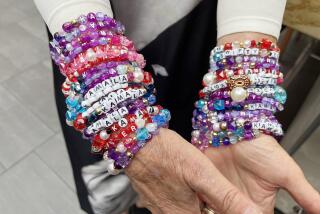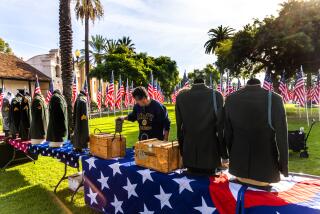The Final Link
- Share via
When Linden Dix, now a retired British schoolteacher, bought a POW/MIA bracelet 29 years ago in New York City, there was no way she could have known it would lead her to Santa Barbara on Sunday.
The 54-year-old resident of Northumberland, England, was one of several hundred who attended a memorial service for Roscoe “Ross” Fobair, a U.S. Air Force lieutenant colonel from the San Fernando Valley who was shot down over Vietnam in 1964 and officially unaccounted for until late last year.
The memorial was held in a park overlooking the ocean, a pristine setting for family and friends to remember Fobair and begin the process of closure after so many years of uncertainty.
Not only was Fobair’s fate a mystery to his family for years, but also to strangers who wore the bracelets to show support for missing U.S. servicemen. After she bought her bracelet in 1972, Dix wrote several letters to the American government and military inquiring about Fobair, a member of the 45th Tactical Fighter Squadron.
“I was associated with people who were very nervous that they were going to be taken to Vietnam to fight,” said Dix, who in 1972 worked as a teacher at a New Hampshire summer camp for teenagers. “The bracelets had the same effect as a ‘Ban the Bomb’ sign. It meant you were supporting the grass-roots feeling at the time.”
Dix wore the bracelet for 10 years before stashing it away. She said she was reminded of Fobair whenever the war or Vietnam was mentioned on television or in a newspaper. It wasn’t until last month, when Dix was invited to the Santa Barbara ceremony by Fobair’s sister, Betty McDermott of Toluca Lake, that she finally learned Fobair was dead.
“I can’t remember things such as the names of boyfriends in the past, but I’ll always remember Roscoe Fobair,” Dix said.
It took 36 years for Fobair’s family to learn what happened to him. One of Fobair’s teeth and pieces of his uniform were found 45 miles outside Hanoi in 1997, near where his plane crashed.
The discovery was made by an American military task force and documented by Fobair’s nephew, McDermott’s son, Bruce Giffin of Santa Barbara. The tooth was officially deemed Fobair’s by a forensics lab in December.
Also attending the memorial was Lani Ross, a Calabasas woman who had a bracelet with Fobair’s name and learned of the discovery of his remains in an article in The Times.
“The bracelet feels like a piece of history,” said Ross, who bought hers in 1970. “We [she and her husband] were liberal Democrats, young idealists. But we couldn’t be angry at the people who were fighting the war. And we didn’t want to forget those who were left behind.”
Ross said she was moved to tears when she learned Fobair had finally been accounted for. She too was contacted by McDermott and invited to the memorial. At the service, she presented the newly polished bracelet to McDermott, encased in a box with a plaque commemorating Fobair.
Other new acquaintances showed support for McDermott and Giffin by attending. David Fisher of Santa Barbara, who had owned a Fobair bracelet for 12 years, said he was surprised to learn Saturday about the ceremony on television news. He said he felt compelled to show up, and he used a chance meeting with McDermott to give her his bracelet.
“This is about pure support of these families who have lost loved ones,” said Fisher, adding that his family includes many veterans.
The service--with an honor guard and a flyover by planes from Edwards Air Force Base--was also an opportunity for Fobair’s squadron mates to reunite. Many had not seen each other for more than 30 years.
Col. Ken Cordier, who came from Dallas, said he considered himself lucky. He spent six years and three months as a prisoner of war in Hanoi, but at least his family did not have to suffer like Fobair’s, he said.
Maj. Tom Bennison, another member of Fobair’s squadron, said the bracelets galvanized support for those missing in action.
“The cause [of finding POWs and MIAs] would have withered away without focus,” he said. “These bracelets gave it focus.”
McDermott said the support she received from strangers and friends gave her strength over the years.
“I’ve learned that the unbearable can be bearable with the support of MIA families,” she said, speaking at the afternoon ceremony.
Carol Bates Brown, a former Cal State Northridge student who invented the MIA/POW bracelets with a friend 31 years ago, said she still marvels at the wristbands’ ability to bring support to the families and friends of the missing, as well as people who never knew them.
“It’s very special,” she said from Virginia, where she works in the office of Defense POW/Missing Personnel, part of the U.S. Department of Defense. “A lot of people try to get in touch with the families of the person on their bracelet. I just got a letter the other day asking me for someone’s whereabouts.”
The bracelets--5 million of which were sold--were especially popular from 1970 to 1973, Brown said.
Judie Mills Taber, a former coordinator for the National League of POW/MIA Families, said the bracelets were the first open show of support for the missing servicemen and women. Before that, she said, the authorities encouraged families not to talk about their missing loved ones so the enemy would not know who was still unaccounted for.
“The bracelets were a huge encouragement for us,” said Taber, whose brother, Lt. Cmdr. James B. Mills, a Navy aviator, vanished over Vietnam in 1966. “It’s good to know that people, even if they don’t know you, have compassion.”
It’s that compassion that makes it impossible for Dix to give up her Fobair bracelet.
“I feel like he’s been so much a part of my life, I can’t give it away,” she said Sunday. “I feel like I’m the custodian of this bracelet.”
More to Read
Sign up for Essential California
The most important California stories and recommendations in your inbox every morning.
You may occasionally receive promotional content from the Los Angeles Times.











